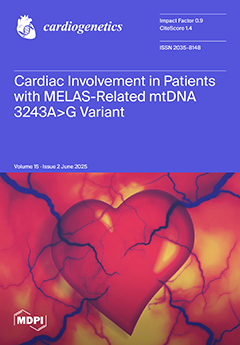Ellis-van Creveld syndrome (EvC) is a rare genetic disorder (7:10,000,000) caused by biallelic pathogenic variants in
EVC and
EVC2, which are located in close proximity on chromosome 4p16.2 in a divergent orientation. These genes encode ciliary complex proteins essential for Hedgehog signaling.
[...] Read more.
Ellis-van Creveld syndrome (EvC) is a rare genetic disorder (7:10,000,000) caused by biallelic pathogenic variants in
EVC and
EVC2, which are located in close proximity on chromosome 4p16.2 in a divergent orientation. These genes encode ciliary complex proteins essential for Hedgehog signaling. EvC is characterized by congenital heart disease (CHD), postaxial polydactyly, and rhizomelic shortening. We present a case of a female newborn from southeast Mexico carrying a novel missense variant in
EVC, which is aligned with a systematic review aimed at exploring genotype–phenotype correlations in EVC-related EvC. A PRISMA-based systematic review was conducted in PubMed, Web of Science, and OVID/Medline (until December 2024). Studies reporting
EVC variants in EvC were included. Data extraction and quality assessment were performed independently by four reviewers, and genotype–phenotype correlation analysis was conducted. Fifteen studies (
n = 66 patients) met the inclusion criteria. The most prevalent features were postaxial polydactyly (95.5%), nail hypoplasia (68.2%), and CHD (66.7%) with atrioventricular canal as the most frequent subtype. Fifty-five distinct
EVC variants across 132 alleles were identified, predominantly affecting the N-terminal region (first 699 amino acids). They were syndactyly correlated with pathogenic variants in exons 6, 12, and 13, which were proximal to the second and third coiled-coil domains. This review confirms the key clinical features of
EVC-related EvC and highlights genetic heterogeneity. The correlation between syndactyly and specific exonic variants suggests potential genotype–phenotype associations, warranting further functional studies.
Full article





